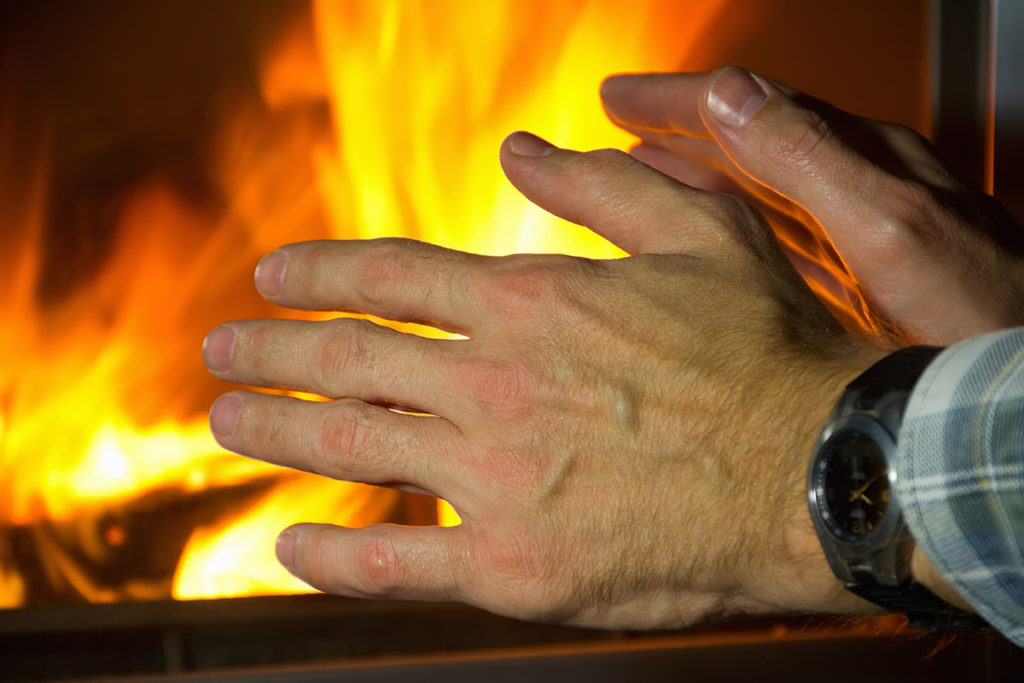Colder weather is just around the corner (brrr!), making us appreciate the invention of indoor heating! Have you ever wondered how amazing inventions came to be? The evolution of central heating systems dates back many, many years ago, advancing from campfires to hearths to fireplaces to stoves and even underfloor systems to become the modern central air systems that we appreciate and enjoy today.
You probably won’t be surprised to learn that the first indoor heating source came from fire. Our Homo Erectus ancestors used fire almost 1.5 million years ago, during the Early Stone Age, mostly as a practical tool and often by accident.1 The earliest fire sites that archeologists have studied appear to be more representative ofthe opportunistic use of natural fires. By examining data from various European sites, archeologists concluded that habitual use of fire wasn’t part of human behavior until 300,00 – 400,000 years ago.
Learning to control fire is probably one of the greatest discoveries for mankind. Just think about it, fire was used thousands of years ago to heat food, provide warmth, create tools, keep predators away, and provide a place to gather around.2 At some point those campfires made their way into caves and huts, providing the first “indoor” heating source. The earliest examples of fire used for heat involves dwellings constructed with openings in the roof for smoke to escape. Unfortunately, most of the heat escaped along with the smoke. The first uses of central heat were not very efficient!
The next step in this evolution comes between 200,000 and 40,000 years ago with the invention of the hearth. This was a simple collection of stones that contained the fire or was created by reusing the same location more than once, allowing the ash from the previous fires to build up. Between 10,000 – 40,000 years ago a new hearth emerged that was banked or sometimes made of domed clay structures. This type of hearth provided two purposes, cooking, and heating.
Crude fireplace heating had widespread use in Europe by the 13th century. Castles were built with fireplaces using primitive, short-flued chimneys. In the early 1600s, Louis Savot of France, an architect, created a fireplace in which air could be drawn through passes under the hearth containing a raised grate and then discharged back into the room. “Cool air would enter at the bottom, be warmed and discharged back into the room through openings above the mantle.”3
Radiant heating systems were seen as early as 80 B.C. During the Roman empire, Sergius Orata created the first recorded underfloor heating systems.1 Originally these systems provided heated floors but later used a heated wall system as well. Much like today’s central air systems, these systems introduced heated air through floor openings. Underfloor heating systems didn’t appear again until 1300 B.C. in the Middle East with King Arzawa having installed such a system in his palace in Turkey.
Systems similar to today’s central warm air heating may date back to as early as the year 200.1 Roman Emperor Helioggabalus4 was said to have had his palace warmed by air. “Using a stove placed in a brick chamber under the rooms, outside air was ducted into the chamber under the stove, and then the heated air would flow through the opening into the rooms above.”1
The Industrial Revolution brought the most significant improvements to central air systems when William Strutt of England invented a system that utilized both duct systems and dampers. The first U.S. building to be centrally heated is said to be the Massachusetts Medical College in 1816. Here we see a basement furnace and ductwork running to individual rooms.
Today’s systems have come a long way from the campfires of our early ancestors. We now have smart heating systems that can control comfort levels room by room and programmablethermostats that enable us to provide the most comfort when we’re home while not wasting energy when we’re away. Modern heating systems are constantly being improved with greater functionality, comfort, and efficiency.
Thanks for joining us on this journey through history! At Rainaldi Home Services, we stay on top of this ever-evolving technology and provide our customers with the best innovations on the market. Give us call us at (407) 413-9795 for all of your heating questions and service needs.
1“An Early History Of Comfort Heating.” ACHR News RSS, ACHR News, 25 July 2019, https://www.achrnews.com/articles/87035-an-early-history-of-comfort-heating.
2 Hirst, K. Kris. “When Did People Begin Using Fire?” ThoughtCo, ThoughtCo, 4 May 2019, https://www.thoughtco.com/the-discovery-of-fire-169517.
3 Britannica, The Editors of Encyclopaedia. “Fireplace.” Encyclopædia Britannica, Encyclopædia Britannica, Inc., https://www.britannica.com/technology/fireplace#ref250646.
4Britannica, The Editors of Encyclopaedia. “Elagabalus.” Encyclopædia Britannica, Encyclopædia Britannica, Inc., https://www.britannica.com/biography/Elagabalus.

